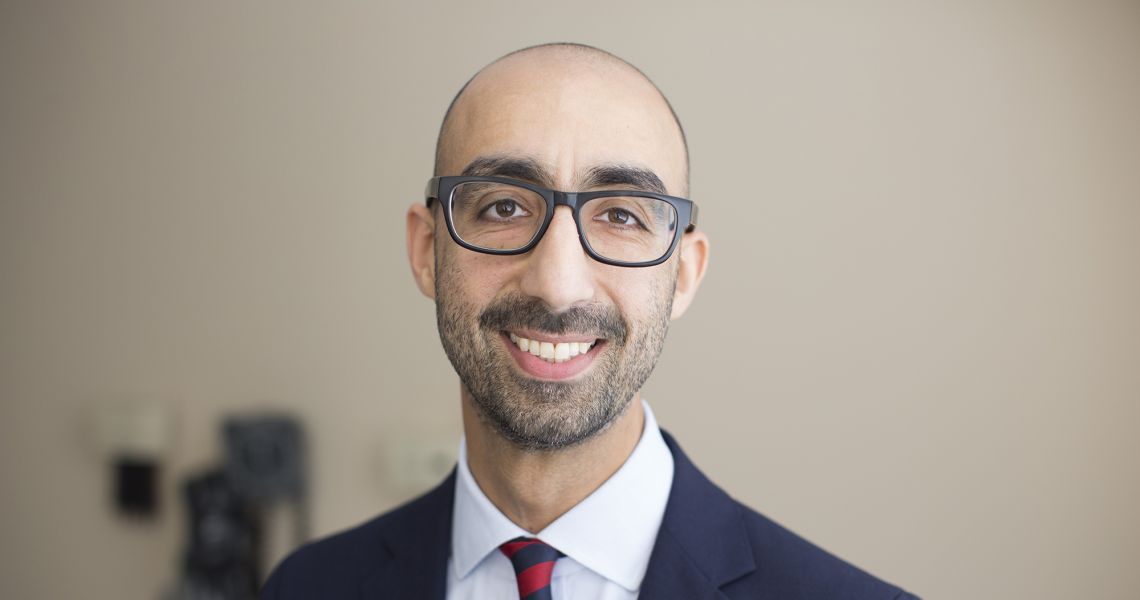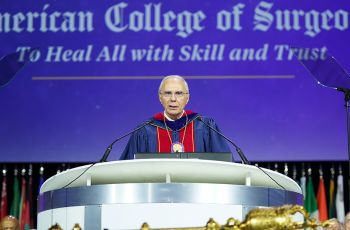Helen Milby, a patient at the George Washington University (GW) Medical Faculty Associates (MFA), chatted while keeping her right arm extended and still. She suspected that her wrist pain, diagnosed as tendonitis, stemmed from overuse. “Probably from my phone,” she guessed.
Around her, fourth-year orthopedic surgery resident Travis Stoll, MD, and Armando De Majo, medical assistant, worked smoothly and silently – a well-oiled machine – as Sam Moghtaderi, MD, assistant professor of orthopaedic surgery and program director of the orthopaedic surgery residency at the GW School of Medicine and Health Sciences, removed a cyst and performed a De Quervain’s tendon release on Milby. The surgery, which opens the tissue around the tendon to reduce pressure and allow the tendon to move freely without pain, took only five minutes; it took longer to prep and then suture the incision.
What’s striking about this type of procedure, known as WALANT (Wide Awake Local Anesthesia No Tourniquet) surgery, is that Moghtaderi performs it in an office, rather than an operating room. The patient receives local rather than general anesthesia, hence “Wide Awake,” and the process is significantly more efficient, particularly in terms of patient comfort, time, waste, and money.
According to Moghtaderi, patients benefit from Wide Awake surgery – usually performed after other noninvasive treatments have failed – because it’s convenient. They don’t have to check into a hospital, they’re not paying larger bills for procedures that incorporate costs for operating rooms, anesthesiologists, and surgical materials, and they can make a follow-up appointment before they leave the office. It’s also safer for patients for whom deeper anesthesia can be medically risky.
Beyond convenience, Moghtaderi, who has outfitted an examination room in the GW MFA Department of Orthopaedic Surgery as a surgical room, has ensured that there is little waste of supplies.
“We have handpicked everything that is in here,” Moghtaderi said. “Our vendor has made custom packs that have exactly what we use in these procedures and nothing more.”
In the long run, he adds, performing Wide Awake procedures in the office will be a significant improvement. “We have lowered the cost of the health care system, made it better for the patients, and made it better for us.”
In our Q&A below, Moghtaderi takes us through the ins and outs of Wide Awake and what patients can expect.
What is Wide Awake hand surgery?
Moghtaderi: It is an emerging surgical technique where we maximize the use of local anesthesia to then do the procedures without sedation or going to sleep. It also has allowed us to do procedures in the office, as opposed to previously having to do them in the full operating room.
What are the benefits of this technique?
Moghtaderi: There are a number of benefits for patients:
- Not having “big anesthesia,” such as sedation or general, means not having to fast, not having to do any pre-testing, and not having to have someone accompany you. Not having sedation also means that you avoid the nausea, the general feeling of being “out of it,” and other side effects afterwards. It also means that it is safer for patients who have multiple medical conditions and may be at high risk with general anesthesia.
- It’s much more convenient for patients since it is set up just like an office appointment. No need to change out of your regular clothes or be in the hospital OR.
- There is decreased cost since there are no hospital fees and thus no surgical co-pays.
Which injuries and patients are best suited for Wide Awake hand surgery?
Moghtaderi: We are able to do quite a few of the common hand procedures in this way. The most common are carpal tunnel release, trigger finger release, tendon repairs, and removal of growths and lumps. Bigger procedures, such as fractures, are typically still treated in the operating room.
As far as patients, the Wide Awake technique can be suitable for almost everybody. It is especially helpful in that it can allow us to do surgery even for people who have complex medical problems and might be at too high of a risk to have “traditional” sedation or anesthesia.
What can patients expect during this kind of surgery? What is recovery like?
Moghtaderi: Patients will have an appointment in our regular clinic office and can expect to spend about 1–2 hours here. The steps of the process are:
- I first meet with the patient and administer their local anesthesia. We have a lot of specific techniques that we use in doing this so that it hurts very little. Typically, the discomfort is less than that of having an IV put in, or having a blood draw. Then we have them sit for about 20 minutes to allow the medication to take effect and for their hand to get fully numb.
- Next, we walk the patient to our procedure room, where they lie down on an exam bed with a side table for their hand.
- While we do the procedure, we put on some music to set a soothing mood and are happy to let the patient pick the songs!
- The procedures themselves are typically short, anywhere from 10 to 30 minutes. Usually, the patient is so relaxed that they are surprised when I tell them that it is over.
- Patients don’t need to see any of the surgery, and in most cases, they are not interested in it. There is a sheet on their upper arm to keep the field sterile and separate them from the surgery. Some patients are interested in what’s going on, though, and would like to observe. When that’s the case, we certainly can let them take a peek, and I do show them what we are doing.
- Another nice thing about having the patient awake during the procedure is that it gives me a lot of time to talk to them. In addition to keeping them informed about how the surgery is going, I have plenty of opportunity to explain to them their post-op instructions and expectations, as well as answer questions about their recovery. By the time we are done with the procedure, we’ve had a chance to have a thorough conversation and they leave well-informed and confident. And because they were never sedated, they remember everything we talked about. (With general anesthesia and sedation, what patients often don’t realize is that there is an amnesia effect, and they often forget the conversations that they have with their doctor in the recovery room!)
- When they are done, they can just get up and leave. There is no lengthy recovery process (actually, no need for any recovery process!). Since they are already at the office, they also just stop at the checkout desk to confirm their post-op appointment.
Do patients worry that they will feel the surgery or be uncomfortable?
Moghtaderi: Of course, it is something that patients will often be concerned about and ask about. But I can tell them with confidence that the local anesthetic will completely numb the areas of their hand that we are working on, so they will feel no pain during the surgery.
We use a specific “slow” technique of injecting anesthetic that really minimizes the pain of the initial injection, and it is typically less than the pain of the IV needle that someone would get for sedation anesthesia. Letting the medication then have 20 minutes to take effect before we do the surgery is also key in making sure they are fully numb.
Occasionally, I have patients who worry about being awake, but it turns out that when you remain awake, you don’t have the disorientation of anesthesia and, overall, you end up experiencing much less pain and discomfort.
Patients having the Wide Awake procedures tend to experience less pain after surgery and need fewer prescribed pain medications than those who have sedation. Part of this is due to the fact that their body doesn’t experience a sudden wake-up from anesthesia to unexpected pain, since everything is gradual and they are aware of their sensation the whole time when awake. It also helps that we have all that conversation time where I get to thoroughly explain the ideal strategies to use minimal medications and decrease post-op pain.
What kind of feedback have you received from patients?
Moghtaderi: The feedback is so positive. I often tell patients that my goal is for you to leave here today thinking, “This whole thing was way easier than I had thought it would be!” I am delighted that just about everybody leaves their procedure feeling that way, especially when it is a patient who had come in feeling nervous beforehand.
To make an appointment with an orthopaedic surgeon, visit the GW MFA Department of Orthopaedic Surgery or call 202-741-3300.




